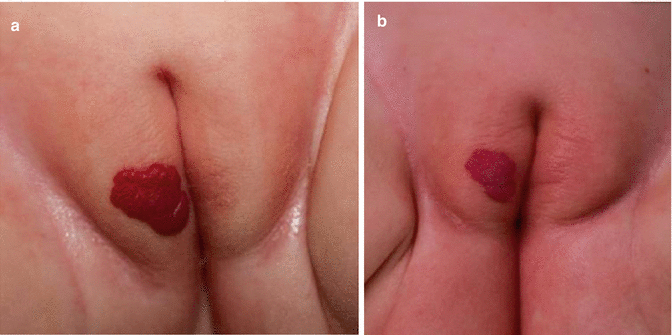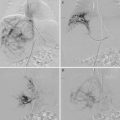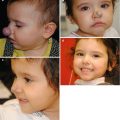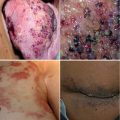Fig. 11.1
A young girl with a segmental IH and PHACE syndrome (dysplasia of left carotid artery) treated with oral propranolol. (a) At 1 month of age (D0), (b) after 3 months of treatment, and (c) at 12 months of age when stopping propranolol
In practice, after eliminating contraindications, oral propranolol is given at a progressive dosage until 2–3 mg/kg/day under medical supervision (see Table 11.1) [2]. The main contraindications are cardiologic, especially sinus bradycardia and partial auriculoventricular block, which should be excluded by cardiologic examination. Concerning PHACES syndrome with cerebrovascular involvement, recent data are reassuring; clinical series did not report side effects [18], and hemodynamic data showed no difference in terms of cerebral vascularization before and after propranolol treatment [19]. Asthma is also a classic contraindication, but it is difficult to detect in young infants; predisposed babies can start wheezing during the beta-blocker treatment, especially in case of concomitant viral infection. In this situation, it is recommended to stop temporarily the propranolol or definitively in case of relapse. Parents should be strongly informed of the risk of hypoglycemia [20], and the child should be carefully monitored especially if there is a discordance in appetite, i.e., the child does not eat at regular times. Other adverse effects can be noted during the treatment including asymptomatic blood pressure drop or bradycardia, insomnia, agitation, and nightmares [2]. Some cases of hyperkalemia have been reported [21]; hyperkalemia is not due to the drug itself but is the result of tumor lysis. As a consequence, blood potassium rate should be monitored in case of a large and/or ulcerated IH treated with beta-blockers.
Table 11.1
Oral propranolol in infantile hemangiomas for practitioners
When? |
In life-threatening IH, in case of functional risks (i.e., risk of amblyopia), painful ulcerated IH, and to avoid sequels needing surgery (i.e., IH involving the nose or lips) |
The earliest is the best to avoid definitive anatomical distortion and development of fibrofatty tissue |
How? |
After elimination of contraindications (sinus bradycardia and partial auriculoventricular block) |
2–3 mg/kg/day in two or three intakes, under close monitoring for the first intake: blood pressure and heart rate for 4 h |
What is the best dosage? |
Begin at 1 mg/kg/day for 1 week, then increase to 2 mg/kg/day, and then 3 mg/kg/day if the tolerance is good |
In case of incomplete result after 1 month, increase at 4 mg/kg/day (maximum dosage not known, but probably not useful to give more than 4 mg/kg/day) |
What is the duration of treatment? |
6 months of treatment |
3 or 6 months more in case of relapse (lH with a deep component and/or segmental IH) |
What to do to avoid expected side effects? |
Minor side effects: nothing to do in case of cold hands or asymptomatic low systolic blood pressur0e. For nightmares avoid giving the treatment after 5 pm and/or reduce the dosage |
Severe side effects: to avoid hypoglycemia, be sure that the infant feeds regularly; in case of poor food intake stop temporarily the propranolol; in case of wheezing, stop also temporarily the propranolol |
Necessity to monitor potassium blood rate in case of very large and/or ulcerated hemangioma |
Propranolol intake should be maintained for 6 months. When stopping propranolol treatment, mild recoloration may be noted in ¼ of cases [2, 9, 22]; among these infants 50 % needed to be retreated 3 or 6 months more because of regrowth of the IH. Segmental IH as well as IH with a deep component is more at risk for relapse [22].
Other Beta-Blockers
Good clinical results have also been reported with other beta-blockers, but as small series or case reports; randomized comparative studies are lacking. Acebutolol [23] and atenolol [24] are both cardioselective beta-blockers; they are said to induce less bronchospasm, and they are proposed as an alternative therapy in infants predisposed to asthma. However, at high dosages the cardioselectivity is not warranted. They are also less lipophilic than propranolol and thus less responsible for nightmares. Nadolol has shown good efficacy but with the same rate of short-term side effects as propranolol [25].
Topical Beta-Blockers
For common non alarming IH, therapeutic abstention is the rule in most instances. Local treatments (corticosteroids, imiquimod, liquid nitrogen applications, etc.) have not yet provided evidence of a good benefit/risk ratio, and their efficacy is not clearly established.
The development of local treatments based on the dramatic efficacy of beta-blockers seems logical, and some authors have published a positive experience with topical timolol. The local treatment concerns only superficial IH (Fig. 11.2); ophthalmic gels have been used first on eyelids [26] and then extended to the skin [27]. Recently, a randomized placebo-controlled study showed that topical timolol maleate 0.5 % gel with a maximum dose of 0.5 mg/day is a safe and effective option for small superficial IHs that have not ulcerated and are not on mucosal surfaces [28]. In our experience, the treatment is more efficient under occlusion [29]; however, tolerance for the dressings is a limiting factor. A homemade topical form of propranolol seems efficient [30], and a pharmaceutical gel is under development.


Fig. 11.2
Superficial hemangioma of the right labia majora in a young girl treated with topical timolol. (a) At 2 months of age (D0) and (b) after 3 months of extended-release 0.5 % timolol solution applied twice daily
References
1.
Léauté-Labrèze C, Dumas de la Roque E et al (2008) Propranolol for severe hemangiomas of infancy. N Engl J Med 358:2650–2651CrossRef
2.
Drolet BA, Frommelt PC, Chamlin SL, Haggstrom A, Bauman NM, Chiu YE, Chun RH, Garzon MC, Holland KE, Liberman L, MacLellan-Tobert S, Mancini AJ, Metry D, Puttgen KB, Seefeldt M, Sidbury R, Ward KM, Blei F, Baselga E, Cassidy L, Darrow DH, Joachim S, Kwon EK, Martin K, Perkins J, Siegel DH, Boucek RJ, Frieden IJ (2013) Initiation and use of propranolol for infantile hemangioma: report of a consensus conference. Pediatrics 131(1):128–140CrossRefPubMedCentralPubMed
Stay updated, free articles. Join our Telegram channel

Full access? Get Clinical Tree








